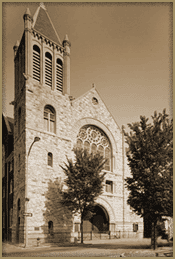







 |
 |
 |
 |
 |
| |
Where did the Underground Railroad go?
The Underground Railroad went north to freedom. Sometimes passengers stopped when they reached a free state such as Pennsylvania, New Jersey, or Ohio. After 1850, most escaping enslaved people traveled all the way to Canada. They had to go to Canada to make sure they would be safe. The reason was that the United States Congress passed a law in 1850 called The Fugitive Slave Act.

The Mother Bethel A.M.E. Church in Philadelphia was an important stop on the Underground Railroad as the “passengers” headed North to freedom.
|
The Fugitive Slave Act was part of a compromise made between northerners and southerners trying to prevent the nation from going to war over the question of slavery in 1850. The new law required every individual in every state, even "free" states, to return runaways.
Because it was dangerous to be in free states like Pennsylvania, New Jersey, Ohio, or even Massachusetts after 1850, most people hoping to escape traveled all the way to Canada. So, you could say that the Underground Railroad went from the American south to Canada.
What routes did the Underground Railroad follow through Maryland?
« back to About home
|
|
 |
 |
 |
|
 |
|










